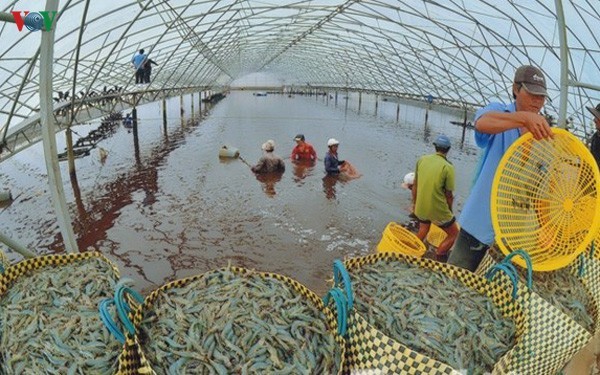(VOVWORLD) - Last year Vietnam earned nearly 4 billion USD from exporting shrimp products. The Ca Mau Peninsula, one of the country’s key areas of brackish water shrimp aquaculture, is aiming to produce 1.1 million tons and earn 10 billion USD in exports by 2025.
 A shrimp harvest shrimp in Ca Mau province A shrimp harvest shrimp in Ca Mau province |
Huynh Van Dung in Tan Bang commune, Ca Mau province, has pursued a rice-shrimp farming model for more than a decade. A few years ago, salt intrusion and epidemics caused great losses on his 1.5 ha farmland.
But thanks to a project to improve the sustainability of the shrimp-rice farming system, his family's shrimp farming productivity has increased steadily. By applying new techniques, Dung can earn 3,500 USD per hectare a year.
Dung told VOV: “The rice-shrimp farming model is more efficient. Rice cultivation is harder but results in lower economic efficiency. The shrimp price is high now, yielding from 20 to 35 USD per kilo.”
Bac Lieu province, the second largest shrimp farming area in Vietnam after Ca Mau, has more than 34,000 hectares of land applying the rice-shrimp farming model.
Aiming to become the hub of Vietnam’s shrimp production, Bac Lieu is applying science and technology to shrimp farming models. The model of super-intensive shrimp farming in a closed house of Vietnam-Australia Company yields a yearly productivity of 100 tons per ha. Many local businesses and farmers have shifted to this model, raising Bac Lieu’s total shrimp production last year to more than 142,000 tons, up 10% against the previous year.
Duong Thanh Trung, Chairman of the provincial People's Committee, said Bac Lieu has constructed a high-tech shrimp production zone covering 418 ha and with total investment of more than 43 million USD.
“20 investors have registered in the high-tech zone. Several institutes and universities have followed suit because they want to introduce scientific and technological advances in shrimp production to make the zone a national shrimp production hub. We hope in the future the high-tech zone and high-tech farming models will be expanded across Bac Lieu province and the Ca Mau Peninsula in general,” said Trung.
 A safe shrimp farming model in Soc Trang province A safe shrimp farming model in Soc Trang province |
Vietnamese shrimp has long been popular to consumers around the world and available in nearly 80 countries and territories. Every year, it contributes about 4 billion USD to the national export turnover.
Nguyen Viet Trung, Head of the Trade Section of Ca Mau’s Department of Industry and Trade, said there remain lots of difficulties for the sector including technical barriers.
Vietnam's seafood has been imposed with the EU’s yellow card leading to stricter control for shrimp products. In addition to traditional markets such as the US, China, Japan, and South Korea, Vietnamese exporters have expanded export markets to Russia and Britain and paid greater attention to the domestic market. Trung said: “Exports are a fundamental direction to improve the value of agricultural products. We have exported shrimp products to many countries, helping gain high profits. Thanks to attaching more importance to the domestic market, Ca Mau’s shrimp products have become widely popular among Vietnamese consumers, especially in HCMC and Hanoi. The export of Ca Mau’s shrimp and other types of seafood is expected to continue to grow in the future.”
According to the National Action Plan for the Development of the Shrimp Industry through 2025:
- Total area for raising brackish water shrimp is estimated to reach 710,000 ha with total output of 832,000 tons of shrimp with a brackish shrimp export value of 4.5 billion USD by 2020.
- It is expected to expand to 750,000 ha with 1.1 million tons of output and an export value of 8.4 billion USD during the 2021-2025 period.
- Shrimp export is expected to total 10 billion USD by 2025.